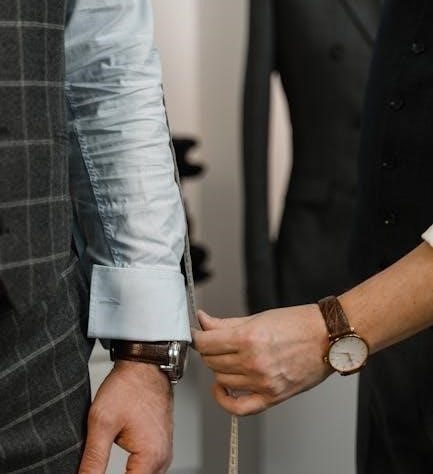Measuring for a men’s suit ensures a tailored fit, enhancing both comfort and style․ Proper measurements are essential for jackets, trousers, and shirts to achieve a flawless look and feel․
Importance of Proper Fit in Menswear
A well-tailored suit enhances confidence and professionalism, making proper fit crucial․ A perfect fit ensures comfort and style, avoiding restrictive or overly loose clothing․ Incorrect measurements can lead to an unflattering appearance, affecting both aesthetics and comfort․ Understanding the importance of accurate sizing ensures a polished look, essential for formal events or business settings․ Proper fit also extends the lifespan of the suit, preventing unnecessary alterations․ Investing time in precise measurements guarantees a garment that complements the body, creating a sharp, put-together image․ Whether for a wedding or a job interview, a perfectly fitted suit makes a lasting impression, reflecting attention to detail and personal style․
Understanding Basic Measurement Terminology
Mastering basic measurement terms is crucial for ensuring accuracy․ Key terms include chest size, measured around the widest point, and shoulder length, from the base of the neck to the shoulder tip․ Waist size is taken at the natural waistline, while hip size is measured 7-9 inches below the waist․ Sleeve length is from the shoulder seam to the wrist, and jacket length is from the base of the collar to the hem․ Trousers require measuring the waist, hip, and inseam․ Using a flexible tape measure and consistent techniques ensures precise results․ Understanding these terms helps in achieving a tailored fit and avoids common sizing errors․
Tools You Need to Measure for a Suit
To measure for a men’s suit accurately, you’ll need a few essential tools․ A flexible tape measure is the most critical tool, as it allows for precise body measurements․ A mirror is helpful to ensure the tape measure is properly aligned․ You’ll also need a pen and paper to record your measurements․ For jacket and trouser measurements, having a second person assist can improve accuracy․ Additionally, wearing a lightweight, form-fitting shirt and thin belt during measurements helps achieve the best results․ These tools ensure you can gather all necessary measurements for a tailored fit, whether you’re measuring yourself or someone else․
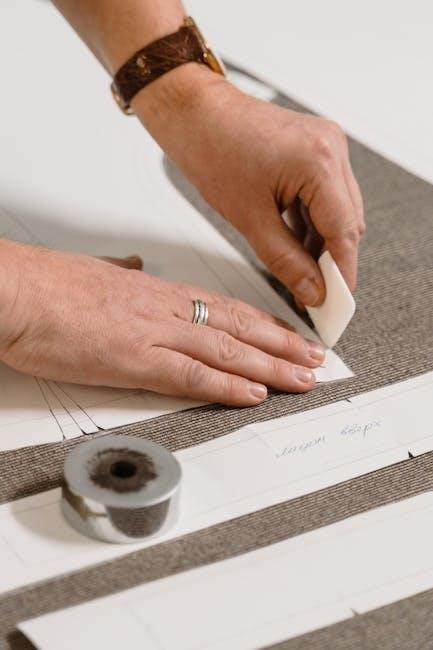
Understanding Suit Measurements
Suit measurements define fit, proportion, and style․ They include chest size, shoulder length, waist, hip, sleeve length, jacket length, and trouser dimensions to ensure a tailored look․
How Suit Sizes Work
Suit sizes are typically determined by combining chest and waist measurements․ Sizes are usually labeled as numbers or combinations like “42L” or “38R,” indicating chest size and fit length․ Chest size is the primary measurement, while waist size is assumed to be 6-8 inches smaller․ Suit sizes vary slightly between US and UK standards, so it’s important to refer to the correct regional size chart․ A good fit ensures the jacket isn’t too tight or loose, with sleeves and trousers proportionate to body length․ Accurate measurements are crucial, as suit sizes are designed to fit specific body types and proportions․ Always double-check measurements for the best fit․
Standard Size Charts for Mens Suits
Standard size charts for men’s suits provide a universal guide to help determine the best fit based on body measurements․ These charts typically include chest, waist, sleeve length, and jacket length measurements․ Sizes are often categorized into numerical or alphabetical formats, such as “38R” or “Medium․” Regional differences exist, with US and UK charts varying slightly․ Most charts assume a proportional relationship between chest and waist measurements․ Accurate interpretation is key to ensure the suit fits comfortably․ Always refer to the specific chart provided by the tailor or retailer, as slight variations may occur․ Double-checking measurements ensures the best fit for any body type․
Key Factors That Affect Fit
Several factors influence how a suit fits, beyond basic measurements․ Body type plays a significant role, as muscular builds, broader shoulders, or a larger midsection require adjustments․ Posture is another key factor; slouching or an upright stance can alter how fabric drapes․ Fabric type and weight also impact fit, as stretchy or heavy materials behave differently․ Weight fluctuations, even slight ones, can change measurements over time․ Seasonal variations in clothing, like layering, may necessitate adjustments․ Ensuring these factors are considered ensures a tailored fit that flatters and comforts․ Regular assessments and open communication with tailors are essential for optimal results․

Measuring for a Men’s Suit
Measuring for a men’s suit requires accuracy to ensure a perfect fit․ Use a flexible tape measure to record chest, waist, shoulders, and sleeve lengths․ Proper tailoring ensures comfort and style․
How to Measure Chest Size
Measuring chest size is crucial for a well-fitting suit․ Stand upright and wrap a flexible tape measure around the widest part of your chest, just under the armpits․ Keep the tape level and snug but not too tight․ Ensure the tape measure is parallel to the floor and not twisted․ Take a deep breath and relax to get an accurate reading․ The chest measurement is the primary factor in determining your suit jacket size․ Record the measurement in inches or centimeters, ensuring it aligns with standard size charts․ Avoid measuring too loosely or tightly, as this can lead to an ill-fitting jacket․
How to Measure Shoulder Length
To measure shoulder length accurately, stand straight and place the tape measure at the tip of one shoulder, just below the neckline․ Extend the tape horizontally to the tip of the opposite shoulder, ensuring it remains level and snug․ Keep your posture natural and avoid slouching․ The measurement should reflect the distance between the two shoulder tips․ This ensures the jacket’s shoulders will sit correctly without sagging or feeling restrictive․ For best results, have someone assist you to maintain accuracy․ Record the measurement precisely, as it directly impacts the fit and comfort of the suit jacket across your upper body․
How to Measure Waist Size
To measure waist size, locate the natural waistline, typically just above the hipbone and below the ribcage․ Stand upright with feet together and wrap a flexible tape measure around this area․ Ensure the tape is snug but not overly tight, keeping it parallel to the floor․ The measurement should reflect the circumference where the trousers will sit․ Avoid sucking in or holding your breath, as this can lead to inaccurate results․ If unsure, mark the point where the waistband of well-fitting trousers rests and measure there․ Record this measurement precisely, as it determines the fit of the suit trousers and jacket․
How to Measure Hip Size
Measuring hip size for a men’s suit involves locating the widest part of the hips, typically around 7-9 inches below the natural waistline; Stand with feet together, ensuring the tape measure is parallel to the floor and not too tight or loose․ The measurement should reflect the circumference where the trousers will sit․ Avoid common mistakes like measuring too high or too low, or applying uneven pressure․ Consistency is key to ensure accurate results․ Follow specific guidelines from tailors or manufacturers, as methods may vary slightly․ This precise measurement is crucial for well-fitting trousers and overall suit comfort․
How to Measure Sleeve Length
To measure sleeve length for a men’s suit, start by bending your arm slightly at the elbow․ Place the tape measure at the center back of your neck, just below the base of the collar․ Gently extend the tape over your shoulder, following the natural curve of your arm, and down to your wrist․ Keep your arm relaxed and avoid pulling the tape too tight or letting it sag․ The measurement should reflect the length where the cuff will sit on your wrist․ This ensures the sleeves are proportional to your body and provides a tailored fit․ Use a standard sleeve length chart to compare your measurement for accuracy․
How to Measure Jacket Length
To measure jacket length for a men’s suit, stand upright and place the tape measure at the base of the collar, directly at the center back of your neck․ From this point, run the tape straight down your spine to the desired jacket length․ The measurement typically ends at the midpoint between your thumb and hip bone or just below the natural waistline, depending on the style․ Ensure the tape lies flat against your back without stretching or sagging․ Jacket length varies by suit style, but standard lengths range from 30 to 34 inches for most men․ This measurement ensures the jacket fits proportionally with your body type and desired aesthetic․ Always refer to size charts for accuracy․
How to Measure Trousers
To measure trousers accurately for a men’s suit, start with the waist size by wrapping the tape measure around the natural waistline, typically where the belt sits․ Ensure the tape is snug but not tight․ Next, measure the hip size by placing the tape around the widest part of your hips, usually 7-9 inches below the waistline․ For the inseam, measure from the base of the zipper down to the bottom of the heel, ensuring the tape runs along the inside of the leg․ Some tailors also measure the seat and outseam for a precise fit․ Always stand upright and wear similar underwear or trousers to ensure accurate measurements․ This ensures the trousers fit comfortably and proportionally with the jacket․ Proper trouser measurements are essential for a polished look․

How to Read a Suit Size Chart
Start by locating your chest measurement on the chart, then cross-reference it with your waist size to find the corresponding suit size․ Match sleeve and jacket lengths to your body measurements for accuracy․ Ensure the numbers align with your specific body type and preferred fit style, whether slim, regular, or loose․ Always double-check the sizing guide for any specific brand variations․ This method ensures a tailored fit that meets your needs and preferences perfectly․ Properly reading the chart guarantees a suit that flatters and fits well․
Understanding Chest and Waist Measurements
When measuring for a men’s suit, chest and waist measurements are critical for achieving the perfect fit․ The chest measurement determines the jacket size, while the waist measurement guides trouser fit․ To measure your chest, wrap the tape around the widest part of your chest, keeping it level and parallel to the floor․ For the waist, measure around the natural waistline, typically one inch above the hip bone․ These measurements ensure the suit jacket and trousers align with your body proportions․ Accurate chest and waist measurements are essential for selecting the correct size from a suit size chart․ Proper alignment ensures comfort and a tailored appearance․
Interpreting Sleeve and Jacket Lengths
Interpreting sleeve and jacket lengths is crucial for ensuring a well-fitted suit․ Sleeve length is measured from the center back of the neck to the wrist, while jacket length is measured from the base of the collar to the hem․ These measurements vary by size and style, with standard jacket lengths ranging from 30 to 34 inches․ Sleeves should be proportional to the jacket, ensuring they aren’t too long or short․ Proper interpretation ensures the suit looks balanced and fits comfortably․ Misjudging these lengths can lead to an ill-fitting suit, so accuracy is key․ Always compare these measurements to the size chart for the best fit․
Converting US and UK Suit Sizes
Converting US and UK suit sizes requires understanding their differences․ US sizes are based on chest measurements in inches, while UK sizes use a similar system but often vary slightly․ For example, a US size 40 chest corresponds to a UK size 40, but fits may differ․ To convert, compare the chest measurements directly, as both systems use numerical sizing․ However, sleeve and jacket lengths may differ due to regional fit preferences․ Always refer to a size chart for accurate conversion, as subtle differences in measurements can affect the fit․ This ensures a suit purchased in either system will fit comfortably and appropriately․

Common Mistakes to Avoid
- Measuring too loosely or tightly can lead to poor fit․
- Not accounting for body type or posture․
- Overlooking fabric stretch and seasonal sizing differences․
Measuring Too Loosely or Too Tightly
One of the most common mistakes when measuring for a men’s suit is inconsistent tension․ Measuring too loosely results in a baggy fit, while too tightly causes restriction․ To avoid this, use a flexible tape measure and ensure it’s snug but not constricting․ Keep the tape level and parallel to the floor to maintain accuracy․ For chest measurements, the tape should sit firmly around the broadest part of the chest, not slipping down or riding up․ Similarly, waist measurements require the tape to be comfortably snug, not digging into the skin․ Proper tension ensures a tailored fit, essential for a polished, professional appearance․ Always double-check measurements for consistency․
Not Considering Body Type
Ignoring body type is a critical error when measuring for a men’s suit․ Different body types, such as muscular, lean, or stocky builds, require tailored fits․ For example, a broader shoulder or chest may need additional room in the jacket, while a slimmer frame might require a narrower cut․ Failing to account for body type can result in a suit that feels restrictive or appears ill-fitting․ To avoid this, consider proportions like shoulder-to-waist ratio and body length․ Ensure measurements align with your physique, and opt for tailored cuts or adjustments, such as darts or extended shoulders, to enhance comfort and aesthetics․ Communication with your tailor is key to achieving the right fit․
Ignoring Fabric Stretch and Seasonality
Overlooking fabric stretch and seasonality can significantly impact suit fit and comfort․ Fabrics like wool and linen naturally stretch, offering flexibility, while synthetic blends like polyester have less give․ Seasonal considerations, such as lightweight fabrics for summer and heavier ones for winter, ensure comfort and practicality․ Ignoring these factors can result in a suit that feels restrictive or unsuitable for the occasion․ For example, a wool suit in summer may cause discomfort, while a linen suit in winter lacks warmth․ Always consider fabric properties and seasonal appropriateness when selecting materials to ensure optimal fit, comfort, and durability․ Professional guidance can help tailor choices to your needs․
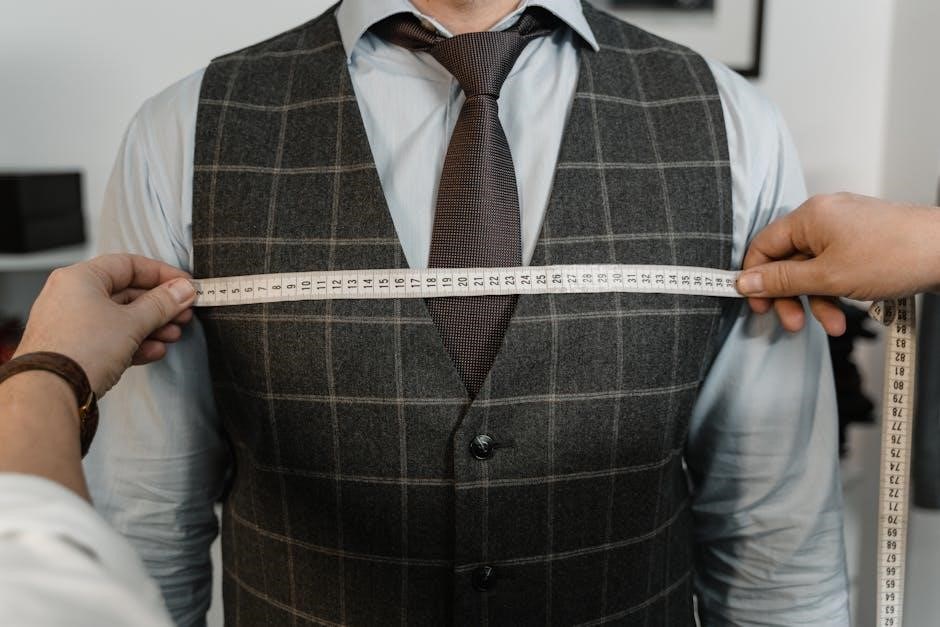
Tips for Getting Measured Professionally
Ensure accurate measurements by visiting an experienced tailor․ Schedule appointments when you’re relaxed, wear similar undergarments and shoes, and avoid eating heavily beforehand for precise results․
What to Expect During a Professional Fitting
A professional fitting typically begins with a tailor introducing themselves and explaining the process․ They will take your measurements systematically, starting with your chest, waist, shoulders, and sleeve length․ Expect them to use a flexible tape measure and ensure it’s snug but not tight․ You may be asked to stand naturally or assume specific poses to gauge the best fit․ The tailor might also ask about your preferences, such as jacket style or trouser break․ Be prepared to try on sample garments to confirm sizing․ The session usually lasts 15–30 minutes, depending on complexity․ Communication is key to achieving your desired fit․

How to Communicate Your Fit Preferences
Clearly expressing your fit preferences ensures your tailor understands your vision․ Start by describing your desired style, such as slim-fit, classic, or relaxed․ Mention specific details like jacket length, trouser break, or shoulder padding․ Share your lifestyle needs, like mobility or comfort, to guide fabric and construction choices․ Discuss any insecurities, such as broad shoulders or a longer torso, to ensure flattering proportions․ Bringing reference images or describing a favorite garment can help convey your preferences․ Be open to the tailor’s expertise but assertive about your priorities․ Effective communication ensures a suit that aligns with your expectations and enhances your confidence․

Using Online Suit Measurement Guides
Online suit measurement guides provide step-by-step instructions and virtual tools to help measure accurately․ They often include videos and size charts to ensure the best fit from home․
How to Use Virtual Size Guides
Virtual size guides are interactive tools that help determine suit measurements using digital inputs․ Users enter body measurements or select clothing sizes, and the guide calculates the best fit․ Many guides include visual aids, such as diagrams or 3D models, to illustrate how measurements correspond to suit sizes․ Some platforms even allow users to input their current wardrobe measurements for comparison․ By leveraging algorithms, virtual guides reduce sizing errors and provide personalized recommendations․ They are especially useful for online shoppers, ensuring a tailored fit without in-person measurements․ Regular updates and real-time adjustments make these tools highly accurate and user-friendly for men seeking a perfect suit fit․
Benefits of Online Measurement Tools
Online measurement tools offer unparalleled convenience and accuracy for men seeking the perfect suit fit․ These tools provide virtual size guides, allowing users to input their measurements and receive tailored recommendations․ They save time by eliminating the need for in-person fittings and are accessible from anywhere․ Many tools include features like interactive tutorials and the ability to save measurements for future purchases․ Additionally, they often account for size variations across brands, ensuring consistency․ Some even incorporate augmented reality for virtual try-ons, enhancing the online shopping experience․ By utilizing these tools, men can achieve a precise fit effortlessly, reducing the likelihood of returns and exchanges․ This convenience and efficiency make online measurement tools an invaluable resource for modern shoppers;
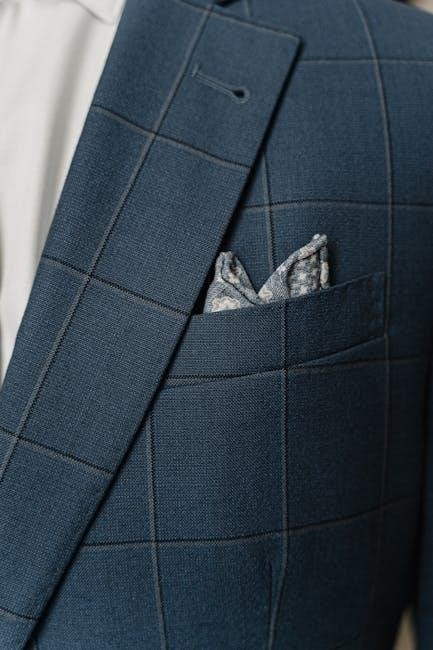
Maintaining the Perfect Fit
Maintaining the perfect fit involves monitoring weight changes and adjusting measurements accordingly, ensuring the suit remains tailored to your body over time for optimal comfort and appearance․
How Weight Changes Affect Suit Fit
Weight changes can significantly impact how a suit fits, altering the balance of proportions and comfort․ Even a slight gain or loss can affect chest, waist, and hip measurements, making the suit feel too tight or too loose․ For example, weight gain may cause the jacket to feel restrictive across the chest or shoulders, while weight loss can result in excess fabric․ Monitoring weight fluctuations and adjusting measurements regularly ensures the suit continues to fit optimally․ Tailors often recommend updating measurements every 6-12 months or after significant weight changes to maintain a tailored appearance and avoid discomfort․ Regular check-ups help prevent issues like a jacket riding up or sleeves being too short․
Adjusting Measurements Over Time
Adjusting measurements over time is crucial to ensure a suit continues to fit perfectly․ As bodies naturally change due to age, lifestyle, or health factors, measurements can shift, affecting the overall fit․ Regularly updating measurements, ideally every 6-12 months, helps maintain a polished appearance․ Weight fluctuations, muscle gain, or posture changes can alter chest, waist, and shoulder dimensions․ Even subtle changes, like shrinking fabric over time, can impact fit․ Staying proactive by reassessing measurements ensures the suit remains tailored to your current physique․ Consulting a tailor for periodic check-ups or updates guarantees a seamless fit and extends the suit’s longevity․ Consistency is key to a timeless, well-fitted look․
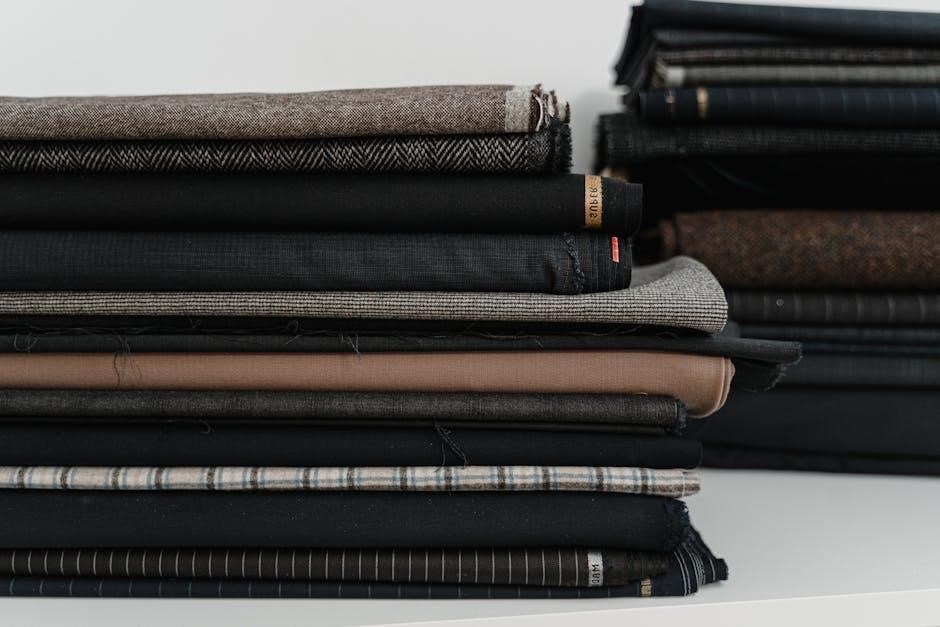
Troubleshooting Fit Issues
Identifying and addressing fit problems early ensures a polished look․ Common issues include tight jackets, ill-fitting trousers, or uneven hems․ Timely adjustments prevent discomfort and maintain style․
When the Jacket Feels Too Tight
A tight jacket can restrict movement and ruin the suit’s appearance․ This often stems from incorrect chest measurements or poor fabric choice․ To fix, ensure chest measurements account for posture and fabric stretch․ If tailored, request adjustments to the seams or consider a larger size․ Shoulder strain indicates the jacket may be too small or poorly fitted․ Additionally, check if the jacket buttons comfortably without pulling․ If issues persist, consult a professional tailor for alterations․ Proper fit ensures both comfort and style, making it essential to address tightness promptly to enjoy your suit confidently․
When the Trousers Are Ill-Fitting
Ill-fitting trousers can detract from the overall appearance of a suit․ Common issues include improper waist measurements, incorrect length, or fabric that lacks flexibility․ To address this, ensure waist measurements are accurate and account for body type․ If trousers feel tight, consider a larger size or a different fabric with stretch․ Length should break slightly above the shoe for a polished look․ If alterations are needed, a tailor can adjust the waistband or hem․ Proper fit enhances comfort and style, making it essential to address ill-fitting trousers for a refined, tailored appearance․ Regular adjustments ensure the best fit over time․
A well-fitted suit enhances confidence and style․ Accurate measurements ensure comfort and a polished look․ Regular updates and professional tailoring maintain the perfect fit over time․
Final Tips for a Perfect Fit
Ensuring a flawless fit starts with precision and attention to detail․ Invest in a quality tape measure and practice measuring techniques to avoid errors․ Always try on the suit before finalizing, and consider professional alterations for adjustments․ Communicate clearly with your tailor about preferences, such as slightly longer sleeves or a streamlined waist․ Bring a trusted friend or family member for an honest opinion․ Schedule fittings at times when your body is at its most neutral state, avoiding weekends or stressful days․ Remember, a well-fitting suit should feel comfortable while standing, sitting, and moving․ Regular check-ins with your tailor ensure long-term satisfaction and adapt to any body changes․
Importance of Regular Measurements
Regular measurements ensure your suit fits perfectly over time, as body changes can occur due to weight fluctuations, muscle growth, or natural aging․ Seasonal variations, such as weight gain or loss, can also impact fit․ Updating your measurements annually helps maintain comfort and style․ Additionally, regular check-ins with your tailor allow for subtle adjustments, ensuring your suit remains tailored to your current physique․ This practice prevents costly alterations and extends the life of your suit․ Consistency in measurements also helps track body changes, enabling proactive adjustments for a flawless fit every time․ Regular updates ensure your suit always looks sharp and feels right․
